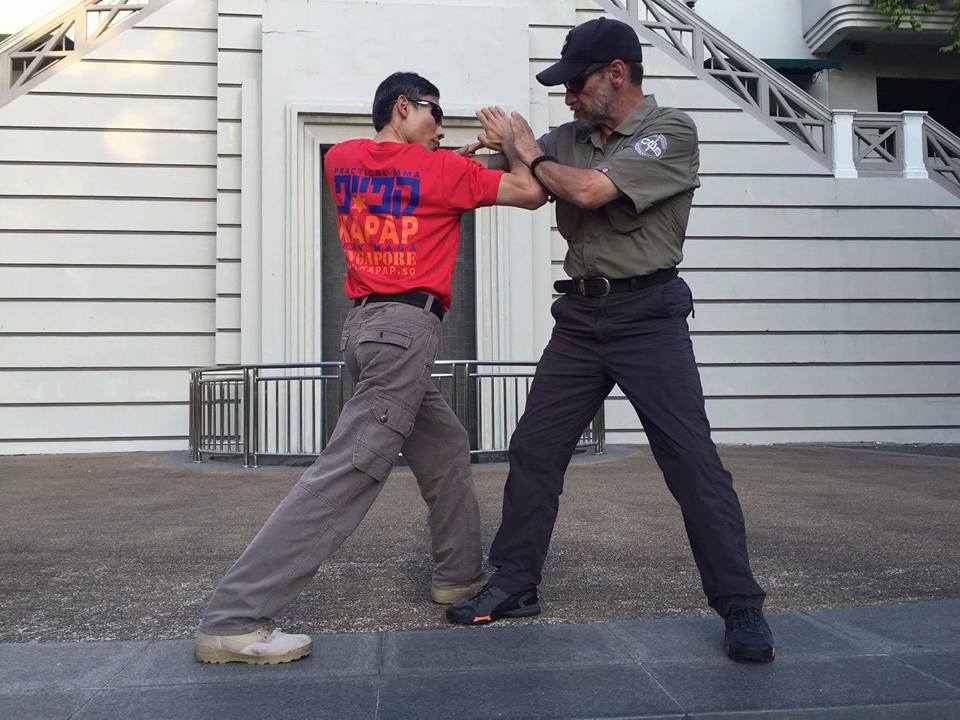Minimum effort, Maximum efficiency -“Seiryoku ZenyO” –
IJJ – The history of Israeli Jiu Jitsu (IJJ) goes back certainly to the first Kapap Instructors: Gerson Kupler (RIP), Yehuda Marcus (RIP), who were among the first generation to bring Judo and Jiu Jitsu into Israel, with a strong influence from Moshe Feldenkris.
How is it that we have forgotten names such as Moshe Feldenkris when talking about Israeli Martial arts?
In the days following the First World War, times were hard. A young Ukrainian immigrant named Moshe Feldenkra moved to the land of pre-Israel and that meant being ready to fight for your life at any moment. Knowing how to fight was not a sport or an exercise fad, it meant survival.
Young Feldenkrais had a scientific mind that sought sound, testable skills which he and his neighbors could use to defend themselves. Japanese jiu jitsu had exploded as an international phenomenon in the early 1900s. Feldenkrais and his peers worked to learn jiu jitsu techniques for real life application in the street. He published a book on jiu jitsu that was based on what he had learned fighting and teaching others with the goal of becoming a training tool for the Haganah, or Jewish defense forces. This book, Jiu-Jitsu and Self Defense (1930), was based on a studying the behavior of humans to develop instinctive or unconscious responses for self-protection and self-preservation. Much of his work was incorporated into the system that became known as KAPAP – Krav Maga today.
Feldenkrais left for France to study engineering and physics in Paris. There he met Judo’s founder, Jigoro Kano, in 1933. Kano encouraged him to study Judo. Feldenkrais learned Judo from Mikonosuke Kawaishi Sensei earning his Shodan in 1936 and a Nidan in 1938. He published several books on Judo including his most important Judo work: Higher Judo
Feldenkrais and Kawaishi founded the Jujitsu Club de France in 1936. This organization eventually became the Federation Francaise de Judo et Jujitsu (FFJJ) in 1946. The FFJJ was instrumental in the creation of the International Judo Federation which oversees sport Judo throughout the world. Paul Bonét-Maury, first IJF Secretary-General, was one of Feldenkrais’ students.
Later in his life, Feldenkrais recalled a phrase that Kano had said to him: “judo is the efficient use of the mind over the body.” Kano also introduced the concept of “Seiryoku ZenyO” to the young Feldenkrais, which means “minimum effort, maximum efficiency”. Kano challenged Moshe to free himself from a reverse cross choke. Moshe attempted to free himself pushing Kano’s throat with his fist, but when this failed, he finally gave up. This impressed Feldenkrais, being 29 years old at the time and effortlessly subdued by a 75 year old Kano. It didn’t take long for Feldenkrais to receive his blackbelt and over time became one of the foremost Judo instructors in France, his reputation soon earning him the title “Pionnier du Judo en France”. His partnership with another key instructor in France, master Mikinosuke Kawaishi, helped him further hone his skill and gave him the necessary foundation to write two books.
At the outbreak of World War II, Feldenkrais escaped Paris and served in the British Admiralty, continuing his role as instructor, now to the British soldiers on base. He retired in 1945 and moved to London, where he was able to continue his study of Judo under grand master G. Koizumi. So impressed was he with the skills of Koizumi, he spoke often the judo master while teaching Awareness Through Movement.
When challenged by the editor of the Budokwai Bulletin to compare the judo at his club with that of other clubs, Moshe responded by saying “I do not think that such criticism would serve any useful purpose. Criticism leading to no improvement is wasted effort and as such is contrary to the spirit of judo. I prefer, therefore, to present to you another way of looking at things you already know…”
Relatively few have heard of Feldenkrais, but his impact on Judo has been large and significant as also I’m sure on Israeli Martial arts.
So why don’t we hear more about Moshe Feldenkrais in Judo and more importantly in Israeli Martial arts? That’s why I determined over the course of the last 20 years to write about Israeli Martial arts and remind people of the names that somehow do not appear in Israeli Martial arts and I’m sure these heroes of the original Israeli Martial arts inspired me when I was younger to take the first steps in Martial arts and study their books.
More names from my childhood come to mind as I used to train under them in what was known as “Practical Judo”, or in other words, Judo as self defense with jiu jitsu. However, what I most remember is my father teaching me the way of martial arts and Budo, with the foundation of them being “Respect”. Many times I have seen in today’s day and age all the people who call themselves martial artists, but who have lost all respect for others and even to themselves by walking around with an attitude of “I’m better than you”, having forgotten the concept of: “It’s not about the size of your stones, but what you build with them!” Tim Boehlert – partner for writing and teaching many times
Around 1992 I returned from many years studying martial arts in Japan where I made the same changes in my mind while studying swordsmanship under Sensei Kubo Akira, and a long list of teachers he sent me to. I studied and explored martial arts with more than 100 teachers to improve my style and see another’s “way”. During these years I also met a great teacher I follow until today, Hanshi Patrick McCarthy, who served as a mentor and big brother, showing me more ways and skills and more teachers as I continued to study Japanese culture and even play shakuhachi – Japanese and Chinese longitudinal and Zen and Kyudo – Japanese archery – Karate under Tadano Tomiyaki, Judo Jiujtsu at Shin Kiba Police academy ( Taiho-Jutsu ) and many more arts to open my mind and provide me with a well-rounded skill set – thereafter returning to Israel.
When I arrived back in Israel, the first thing that shocked me was the closed mind and inability to see things another way. We know the best attitude is to be open to new perspectives and Lt.Colonel Avi Harush (RIP) was the first to help me and get me into the Wingate Army base to start changing the Krav Maga system and over time, the YAMAM, Israel’s top Anti-Terror unit recruited me to be the official instructor and member of a unit with a rank of master sergeant. Since I was working full time in the service, I could not teach civilians anymore and therefore, gave my club to my student, Chaim Peer, as a firewall to present the club and the civilian life as a teacher. Later, I become the Operational Police official instructor in defensive tactics (Hagana and operational behavior and Riot control) and there created the first KAPAP – Krav Maga civilian life class courses. Everyone knew Chaim Peer but not the background and real story and many wild rumors surface on the Internet which are completely wrong, including by few Krav Maga organizations who are attempting a character assassination of my reputation and name. They have tried to take me out from the Krav Maga market by spreading the most evil lies, including that I was never in the Israeli army. I could show I have been Major rank, including the Yamam service documents from my time there, but it seems that many in the Krav Maga community love the baseless rumors more than the truth and over time, even by “Partners and friends.”
I have focused on 3 elements most important to the combative system, the triangle of KAPAP – Krav Maga and IJJ. Historically, KAPAP was the foundation, as more and more people see now that KAPAP is the father from which were born Krav Maga and Jiu Jitsu, which is directed toward the day to day lives of civilians. This allows us to devote time to teach slow as fast and to deal with civilians from different age groups, all the way from kids to grown adults. Through experience it’s better teach all 3 elements: in the short term, we focus on Kapap Krav Maga as an introduction, moving on to the long term study with Jiu Jitsu, as it is a more complete system and because, having done Japanese Jiu Jitsu and Judo, I continue to follow the ranking method. From 5 dan Shihan my leaders receive the red white belt as is the case in Judo, but from 6 dan I want to see them as Teachers Kyoshi and blue white belt as in Israeli Martial arts leaders world wide. My belt is white blue, ending in blue as leader and founder. Those head instructors under me receive the white blue ending with white, followed by the other instructors belt, the red white and finally, the black belt.
I received the blessing of Professor John Machado BJJ, carrying the black belt in his style and also by Hanshi Patrick McCarthy 9 dan, holding the rank of 7 dan under him in Aikijujutsu and now today we have the blessing of many organizations and world wide martial artists and we welcome to our home those good martial artist who demonstrate integrity, honesty and desire to learn. Whenever possible we try to avoid politics, taking the words of Dr. Feldenkris when it comes to critics – “I do not think that such criticism would serve any useful purpose. Criticism leading to no improvement is wasted effort and as such is contrary to the spirit of judo. I prefer, therefore, to present to you another way of looking at things you already know…”
We are filming 3 DVDs with Budo Magazine to share our way and welcome you to Israeli Jiujutsu, also known as IJJ. My next GOAL is to develop International Jiujutsu, combining Japanese BJJ and Israeli Jiujutsu and keep growing together!









